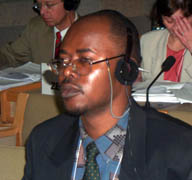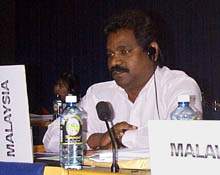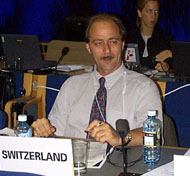 |
 AUSTRALIA suggested SBSTTA review the report of the
AUSTRALIA suggested SBSTTA review the report of the
World Commission on Dams and urged participation in the River Basin
Initiative.
|
|
|
 On marine and coastal biodiversity, PORTUGAL, on behalf of the EU,
welcomed the work programme and referred to coral bleaching, the adverse
effects of climate change, the need for regional cooperation and collaboration
with the UNFCCC and other relevant bodies.
On marine and coastal biodiversity, PORTUGAL, on behalf of the EU,
welcomed the work programme and referred to coral bleaching, the adverse
effects of climate change, the need for regional cooperation and collaboration
with the UNFCCC and other relevant bodies. |
|
WG-1
Chair Peter Schei said a Conference Room Paper containing draft
decisions of the marine ecosystem work programme would be issued
for discussion.
|
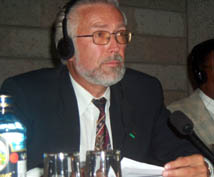 |
|
|
Working
Group Two: NATIONAL REPORTING
|
 The Secretariat introduced background document UNEP/CBD/COP/5/13
The Secretariat introduced background document UNEP/CBD/COP/5/13
and SBSTTA-5
Chair Samper reviewed SBSTTA Recommendation V/13.
|
 ETHIOPIA, on behalf of the G77/CHINA, stated that a standard
format should be used as a reference and not be mandatory.
ETHIOPIA, on behalf of the G77/CHINA, stated that a standard
format should be used as a reference and not be mandatory.
|
 BANGLADESH
suggested extending deadlines for reporting on forests and benefit-sharing
to May 2000, and supported adoption of a set of indicators on the
status of biodiversity keeping in mind each country's unique forms
of life.
BANGLADESH
suggested extending deadlines for reporting on forests and benefit-sharing
to May 2000, and supported adoption of a set of indicators on the
status of biodiversity keeping in mind each country's unique forms
of life.
|
|
|
Working
Group Two: FINANCIAL RESOURCES
AND MECHANISM
|
 The
Secretariat introduced background documents UNEP/CBD/COP/5/7
and 13 and reviewed recent SBSTTA decisions The
Secretariat introduced background documents UNEP/CBD/COP/5/7
and 13 and reviewed recent SBSTTA decisions
|
 On additional financial resources, INDIA
expressed concern over reductions in ODA GEF funding
On additional financial resources, INDIA
expressed concern over reductions in ODA GEF funding
|
|
|
MALAYSIA
highlighted the potential involvement of the private sector in funding
certain CBD activities |
 AUSTRALIA opposed the draft terms of reference of the second
GEF review, noting the need to simplify criteria of assessment
and broaden information sources
AUSTRALIA opposed the draft terms of reference of the second
GEF review, noting the need to simplify criteria of assessment
and broaden information sources
|
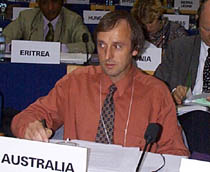 |
|
|
 SWITZERLAND called for a simpler format for reporting financial
support and asked to expand and improve the database on biodiversity-related
funding.
SWITZERLAND called for a simpler format for reporting financial
support and asked to expand and improve the database on biodiversity-related
funding. |
|
|
Working
Group Two: CLEARING-HOUSE MECHANISM
|
|
|
 |
|
|
Press conference: European
Union and the CBD
|
|
 The
European Union held a press briefing on its positions regarding
the biodiversity convention. Christoph Bail , Head of Directorate
General XI - Environment, Nuclear Safety and Civil Protection [christoph.bail@dg11.cec.be,
second from the right] spoke on behalf of the European Commission,
stressing the region's commitment to making the CBD work through
on the ground practices, strategies and action plans. He said European
countries will be signing and implementing the Cartagena Protocol
on Biosafety. He further indicated the European Community's recognition
of the need for guidelines regarding prior informed consent and
mutual agreed terms for access to genetic resources and benefit
sharing measures without infringing on traditional knowledge, including
sui generis systems. He concluded by calling for greater
integration and reconciliation between agricultural production and
the conservation and sustainable use of biodiversity. The
European Union held a press briefing on its positions regarding
the biodiversity convention. Christoph Bail , Head of Directorate
General XI - Environment, Nuclear Safety and Civil Protection [christoph.bail@dg11.cec.be,
second from the right] spoke on behalf of the European Commission,
stressing the region's commitment to making the CBD work through
on the ground practices, strategies and action plans. He said European
countries will be signing and implementing the Cartagena Protocol
on Biosafety. He further indicated the European Community's recognition
of the need for guidelines regarding prior informed consent and
mutual agreed terms for access to genetic resources and benefit
sharing measures without infringing on traditional knowledge, including
sui generis systems. He concluded by calling for greater
integration and reconciliation between agricultural production and
the conservation and sustainable use of biodiversity.
Ensuing
deliberations centered on: the EU's alliance with Africa in bringing
forth the Cartagena Protocol; the importance of capacity-building
in the application of the precautionary principle through biosafety
risk assessment; whether the WTO and CBD Biosafety Protocol are
conflicting or mutually supportive; and the possibility of a protocol
on access and benefit sharing in light of the "window of opportunity"
created with the birth of the Biosafety Protocol as the first legally-binding
biodiversity instrument.
|
|
|
Press
conference: Alien
Species
|
|
 A
press conference on alien species chaired by Rosalind Reeve, Defender
Of Wildlife- Kenya [ros@africaonline.co.ke,
top photo left]. Rich Blaustein, Environmental Lawyer with Defenders-USA
[rblaustein@defenders.org,
top photo right], presented a case for developing an Alien Species
Protocol to the CBD and suggested that COP-5 create an ad hoc
working group for this purpose. A
press conference on alien species chaired by Rosalind Reeve, Defender
Of Wildlife- Kenya [ros@africaonline.co.ke,
top photo left]. Rich Blaustein, Environmental Lawyer with Defenders-USA
[rblaustein@defenders.org,
top photo right], presented a case for developing an Alien Species
Protocol to the CBD and suggested that COP-5 create an ad hoc
working group for this purpose.
Jeff
Waage [j.waage@cabi.org,
middle photo on the left], Chief Executive of the Center for
Applied Biosciences International (CABI),
gave an overview of the global problem of invasive plants, animals
and insects and the environmental damage and biodiversity loss they
create. He emphasized the importance of raising awareness and sharing
information about existing solutions for eradication of such invasive
species. CABI's Global Invasive
 Species
Programme will soon be releasing a tool kit for national programmes
on alien species along with a global database to assist in information-exchange
about them. Species
Programme will soon be releasing a tool kit for national programmes
on alien species along with a global database to assist in information-exchange
about them.
Greg
Sherley [greg@sprep.org.ws,
middle photo on the right], Programme Officer with the South
Pacific Regional Environment Programme [SPREP]
in Samoa, said that invasive species were the major cause of biodiversity
loss in the South Pacific. A regional invasive species strategy
is being developed to include awareness raising, capacity-building
and eradication programmes.
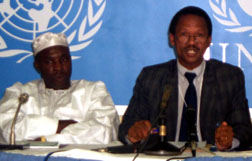 Gasper
Mallya, Operations Officer, Lake Victoria Environmental Management
Programme [bottom photo on the right], described efforts
to eradicate and monitor water hyacinth first introduced in Lake
Victoria in 1987 and now a severe problem causing transportation
interference, the reduction of light and oxygen in the lake and
biodiversity loss. Gasper
Mallya, Operations Officer, Lake Victoria Environmental Management
Programme [bottom photo on the right], described efforts
to eradicate and monitor water hyacinth first introduced in Lake
Victoria in 1987 and now a severe problem causing transportation
interference, the reduction of light and oxygen in the lake and
biodiversity loss.
Soulèye Ndiaye, Senegal's National Parks Director [bottom photo
on the left], emphasized the real threat that invasive aquatic
weeds, such as water lettuce and hyacinth, cause to the biodiversity
and socio-economic conditions of West African riparian zones and
lagoons. He recommended that COP-5 set up a committee on invasive
species in dryland areas.
For
more information on the DOW proposal for an Alien Species Protocol,
see [http://www.defenders.org/]
|
|
|
Press
conference: Genetic
Resources
|
|
The
World Resources Institute held
a press briefing on governments' efforts to establish a system whereby
a country that grants a company or organization access to its genetic
resources can receive in return a fair share of the profits or other
benefits.
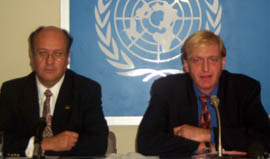 Chip
Barber, World Resources Institute Philippines [top photo, right],
presented on the joint responsibility of providers and users of
genetic resources to develop legislation regarding the commercialization
of genetic materials, noting that developing countries have tended
to develop defensive legislation which impedes rather than enhances
the flow of genetic resources. Chip
Barber, World Resources Institute Philippines [top photo, right],
presented on the joint responsibility of providers and users of
genetic resources to develop legislation regarding the commercialization
of genetic materials, noting that developing countries have tended
to develop defensive legislation which impedes rather than enhances
the flow of genetic resources.
Mario
Rodriguez, International Chamber of Commerce and Association of
Biotechnology Industries of Mexico [top photo, left], said
that the private sector demands to participate in decision making
on genetic resources access issues in the same way that indigenous
people do and can play an important role in creating enhanced varieties
of foods in developing countries that are source countries of genetic
material.
 François
Pithoud, Swiss COP-5 Delegate [bottom photo, left], expressed
his country's view that the CBD must now rapidly develop guidelines
for access and benefit sharing regulation with attention to balancing
intellectual property, agricultural and environmental concerns. François
Pithoud, Swiss COP-5 Delegate [bottom photo, left], expressed
his country's view that the CBD must now rapidly develop guidelines
for access and benefit sharing regulation with attention to balancing
intellectual property, agricultural and environmental concerns.
Stephen
Schnierer, Director of the College
of Indigenous Australian Peoples, Southern Cross University
[sschnier@scu.edu.au,
bottom photo, right], emphasized that indigenous peoples' concerns
regarding access and benefit-sharing are not limited to genetic
resources exploitation for commercial use. They are also interwoven
with spiritual values and practices as well as cultural dimensions.
These include the right to be part of any decision making process
on access to benefit sharing of genetic resources and a broad range
of rights to protect indigenous knowledge from patenting interests.
He said Western intellectual property rights were fare more individualistic
and less communal than sui generis systems, but that all
options for protecting traditional knowledge should be explored.
These include a wider approach to what benefits could be shared
ranging from cash inputs to capacity-building, local infrastructure,
less exclusive protected area legislation, territorial and cultural
rights and repatriation of pre-CBD collected genetic materials.
The
Press raised questions regarding the boldness of the Swiss proposal
for guidelines on access and benefit sharing as a first step towards
international standards. They further queried on the lack
of attention to pre-CBD germplasm in designated national collections
in Northern countries which may include landraces no longer present
in the South. Further discussion centered on what benefits are expected
from genetic resources and how they can be shared with whom.
|
|
|
Side event: Captain Hook
Awards Ceremony
|
|
 Delegates
to COP-5 gathered outside the conference rooms to witness the bestowing
of Captain Hook Awards - presented by the Coalition Against Biopiracy
(CAB) to acknowledge outstanding achievement in bio-piracy. The
CAB presented "Villain Awards" to "those who plunder genetic
resources" under categories such as "worst corporate offender,"
"worst international convention "and "worst anti-food security."
"Cog Awards" were presented to those who fight biopiracy.
Among the Cog Awards given were "best international convention"
to the FAO-CGIAR Trust Accord [below, left] for it's practical
initiative and firm political defense of farmers' varieties, and
"best national defense" to the Philippines Government [below,
right] for introducing legislation intended to strengthen the
rights of indigenous peoples and local communities against biopiracy. Delegates
to COP-5 gathered outside the conference rooms to witness the bestowing
of Captain Hook Awards - presented by the Coalition Against Biopiracy
(CAB) to acknowledge outstanding achievement in bio-piracy. The
CAB presented "Villain Awards" to "those who plunder genetic
resources" under categories such as "worst corporate offender,"
"worst international convention "and "worst anti-food security."
"Cog Awards" were presented to those who fight biopiracy.
Among the Cog Awards given were "best international convention"
to the FAO-CGIAR Trust Accord [below, left] for it's practical
initiative and firm political defense of farmers' varieties, and
"best national defense" to the Philippines Government [below,
right] for introducing legislation intended to strengthen the
rights of indigenous peoples and local communities against biopiracy.
For
more information on the awards and a list of recipients, please
read either the [News
Release] or the [Communique]
on the RAFI web site.
|
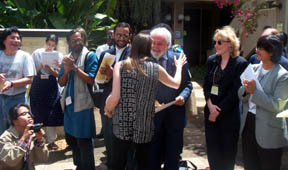
|

|
|
|
Side event: Inter-linkages:
Synergies and Coordination between Multilateral Environmental Agreements
|
|
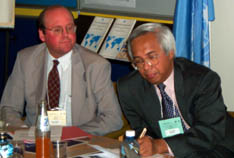 Chaired
by A.H. Zakri (Malaysia, on the right), the session reviewed the
activities of the United Nations University and other organizations
in the area of developing synergies among multilateral environmental
agreements (MEAs). Chaired
by A.H. Zakri (Malaysia, on the right), the session reviewed the
activities of the United Nations University and other organizations
in the area of developing synergies among multilateral environmental
agreements (MEAs).
Bradnee Chambers 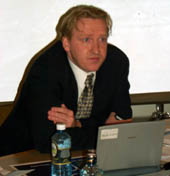 (UNU-Insitute for Advanced Studies, photo on the left) outlined
the results of a conference on the topic held in Tokyo in July 1999.
The meeting made concrete recommendations in the areas of information
harmonization, finance, issue management, scientific mechanisms
and institutions. Chambers also outlined upcoming work focusing
on the inter-relation of the Cartagena Protocol on Biosafety, the
World Trade Organization and the Codex Alimentarius.
(UNU-Insitute for Advanced Studies, photo on the left) outlined
the results of a conference on the topic held in Tokyo in July 1999.
The meeting made concrete recommendations in the areas of information
harmonization, finance, issue management, scientific mechanisms
and institutions. Chambers also outlined upcoming work focusing
on the inter-relation of the Cartagena Protocol on Biosafety, the
World Trade Organization and the Codex Alimentarius.
For
more information: [http://www.interlinkages.net]
(on-line mid-June) or [http://www.geic.or.jp/interlinkages]
Sam
Johnston (CBD Secretariat) highlighted COP-5 issues relevant to
developing synergies among MEAs. At the national and regional levels
he highlighted the role of reporting and discussions on the second
national reports. For subsidiary bodies, he noted discussion of
coordination for scientific input and assessments and linkages between
the advisory bodies of MEAs. At the COP-level, he called attention
to the existing joint work programme with the Ramsar Convention
and current discussions on work with the Convention to Combat Desertification.
Jerry
Velazques (UNU-Global Environment Information Center) reviewed the
UNU's work programme on the topic for the rest of 2000. Some activities
include information dissemination, regional reviews and national
case studies. Specific topics for study include biosafety, ozone-climate
linkages, land degradation, operationalization of the precautionary
principle, linking science with policy and use of an issue management
approach. Other activities include capacity-building for developing
country negotiators.
Michael
Williams, UNEP-Division for Environmental Conventions, [mwilliams@unep.ch,
top photo on the left] introduced UNEP's new publication Synergies,
which promotes collaboration between environmental treaties. Megumi
Seki (UNEP) highlighted UNEP activities in the areas of MEA collaboration,
the second interlinkages assessment, harmonization of national reporting
and the regional seas action plans.
Delmar
Blasco, Ramsar Convention Secretariat [secretariat@ramsar.org],
noted that the issue of interlinkages is taking root although further
time and resources are necessary in order for it to permeate all
levels of activity. He highlighted Ramsar's bilateral cooperation
with the CBD, CCD and Convention on Migratory Species, but noted
the need to work harder on multilateral cooperation among the MEAs.
Mark
Collins (World Conservation Monitoring Centre) reviewed WCMC's past
work on harmonization of reporting under MEAs, noting that information
management has a high potential for developing synergies. He referred
to the use of modular reporting where national reports on a particular
issue could be included under the reporting requirements of different
MEAs.
Ruth
MacKenzie (Foundation for International Environmental Law and Development)
noted the complexity of identifying all of the relevant agreements,
organizations and processes working on a particular issue. She stated
that the CBD has come a long way in developing synergies with other
agreements (e.g., Ramsar and the CCD) and noted tougher work ahead
with the FAO and WTO. She also suggested that Parties look at their
obligations for sectoral integration under CBD Article 6(b).
|
|
|
Side event: Protected Areas
and the CBD
|
|
 David
Sheppard [das@hq.iucn.org,
shown here on the right], IUCN World Commission on Protected
Areas (WCPA) Liaison and Head of IUCN's Programme on Protected Areas,
facilitated a panel on preparations for COP-7 consideration of protected
areas CBD Article 8(a) in 2004, hosted by IUCN-WCPA, The World Resources
Institute (WRI), and the Global Environmental Facility (GEF). He
suggested that the CBD create a new paradigm for linked national
and regional networks of different kinds of protected areas. These
networks should recognize the multiple values of biodiversity conservation
and benefit people. He pointed to the need to accommodate global
coverage of protected areas (33,000 sites near 10% of the earth's
surface), reverse the current trend of species diversity loss, the
"paper park syndrome", narrow range of designated protected areas
categories. He added that gaps in conservation coverage of marine
ecosystems, grasslands, deserts and lakes should be filled. David
Sheppard [das@hq.iucn.org,
shown here on the right], IUCN World Commission on Protected
Areas (WCPA) Liaison and Head of IUCN's Programme on Protected Areas,
facilitated a panel on preparations for COP-7 consideration of protected
areas CBD Article 8(a) in 2004, hosted by IUCN-WCPA, The World Resources
Institute (WRI), and the Global Environmental Facility (GEF). He
suggested that the CBD create a new paradigm for linked national
and regional networks of different kinds of protected areas. These
networks should recognize the multiple values of biodiversity conservation
and benefit people. He pointed to the need to accommodate global
coverage of protected areas (33,000 sites near 10% of the earth's
surface), reverse the current trend of species diversity loss, the
"paper park syndrome", narrow range of designated protected areas
categories. He added that gaps in conservation coverage of marine
ecosystems, grasslands, deserts and lakes should be filled.
 Olivier
Jarbert [secretariat@biodiv.org,
second from the right], Deputy Executive Secretary of CBD, stressed
that protected areas are not "museums of nature" but crucial
to the ecosystem approach and biodiversity conservation. He suggested
that the COP form a liaison group on protected areas to advance
analysis of trends and proposals in time for SBSTTA-7 and COP-7. Olivier
Jarbert [secretariat@biodiv.org,
second from the right], Deputy Executive Secretary of CBD, stressed
that protected areas are not "museums of nature" but crucial
to the ecosystem approach and biodiversity conservation. He suggested
that the COP form a liaison group on protected areas to advance
analysis of trends and proposals in time for SBSTTA-7 and COP-7.
Jeff
McNeely [jmn@hq.iucn.ch,
far right], Chief Scientist of IUCN, stressed that the CBD protected
area strategy and those on domesticated productive landscapes are
equally important to the ecosystem approach. Moreover, protected
areas have been narrowly defined and seen as islands, whereas the
most interesting biodiversity conservation occurs out of legally-designated
areas for local cultural reasons, such as graveyards and sacred
forests or mountains. He expressed hope that the CBD would mainstream
protected areas as a diverse biodiversity conservation tool in ways
that can contribute to national cultures.
Tony
Lavanya, WRI Director of Biological Resources [tlavanya@wri.org,
second from the left], invited participants to join and fund
activities of the WRI-GEF-IUCN-CBD Secretariat Steering Group and
WCPA Task Force on Protected Areas. Their work aims to develop criteria
for innovative protected area categories and management regimes,
define in situ biodiversity conservation options in domesticated
landscapes and identify critical sites for conserving important
ecosystem services.
Walter
Luisigi [wluisigi@worldbank.org,
far left], GEF Biodiversity Specialist and Chair of the International
Planning Committee informed participants on the 5th World Congress
on Protected Areas, entitled "Benefits Beyond Boundaries" to be
held 16-24 September 2002 in Durban, South Africa. Major themes
will include ecological integrity, biodiversity restoration, marine
biodiversity, governance, linkages in landscapes "from islands to
networks" and nature-culture connections. For more information see
[http://www.iucn.org/themes/wcpa/index.html]
Participants
discussed: the recently formed IUCN Inter-Commission Task Force
on Protected Areas and Local Communities, headed by Ashish Kothari,
Environmental Action Group of Kalvapavriksh India [ashish@nda.vsnl.net.in];
whether to add another IUCN protected area category to enable community
ownership or to integrate communities into the management objectives
of existing categories. For more information on networks of protected
areas experts, contact WCPA Chair Adrian Phillips [Adrian.Phillips@wcpa.demon.co.uk]
and Kenton Miller at WRI [kmiller@wri.org]
|
|
|
Side event: Diverse Women,
Access and Benefit Sharing
|
|
Christine
von Wiersacker, ECOROPA Germany chaired a session on access and
benefit sharing hosted by Diverse Women for Diversity (DWD). Speakers
included Wangari Mathai, Greenbelt Movement of Kenya; Tewolde, Egjaibher,
COP-5 Delegate of Ethiopia; Monica Opole, Kenya Center for Indigenous
Knowledge Systems and By-products; Shalini Bhutani, DWD Secretariat,
India. Discussing on the theme of whose access and which benefits,
speakers highlighted the "sovereign rights of local communities"
in the context of access to and benefit-sharing arising from the
use of genetic resources and the prerequisite of "good faith"
between providers and users of genetic resources. For more information,
contact Monica Opole [ciksap@nbnet.co.ke]
or Salini Bhutani [shalinibhutani@hotmail.com]
or visit the DWD web site at [http://www.vshiva.org/]
(follow the DWD link).
|
IN
THE BREEZEWAYS
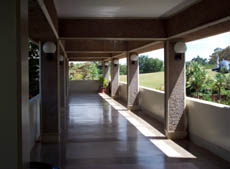 Discussions in the Working Groups and the breezeways have been awash
with talk of cooperation with other environmental agreements. Some
noted positive and proactive collaboration with Ramsar and the CCD
in contrast to lackadaisical responses from the UNFCCC on coral
bleaching and forests. A few delegates suggested that the successful
collaborations partially relate to an incentive to develop ties
with the CBD's financial mechanism. Others wondered whether the
GEF's new operational programme on ecosystem management and its
ties to carbon sequestration would facilitate such activities at
the national level.
Discussions in the Working Groups and the breezeways have been awash
with talk of cooperation with other environmental agreements. Some
noted positive and proactive collaboration with Ramsar and the CCD
in contrast to lackadaisical responses from the UNFCCC on coral
bleaching and forests. A few delegates suggested that the successful
collaborations partially relate to an incentive to develop ties
with the CBD's financial mechanism. Others wondered whether the
GEF's new operational programme on ecosystem management and its
ties to carbon sequestration would facilitate such activities at
the national level.
Right:
at the UN compound at Gigiri, buildings are not separated
by closed corridors, instead they are linked by open breezeways.
|
|


